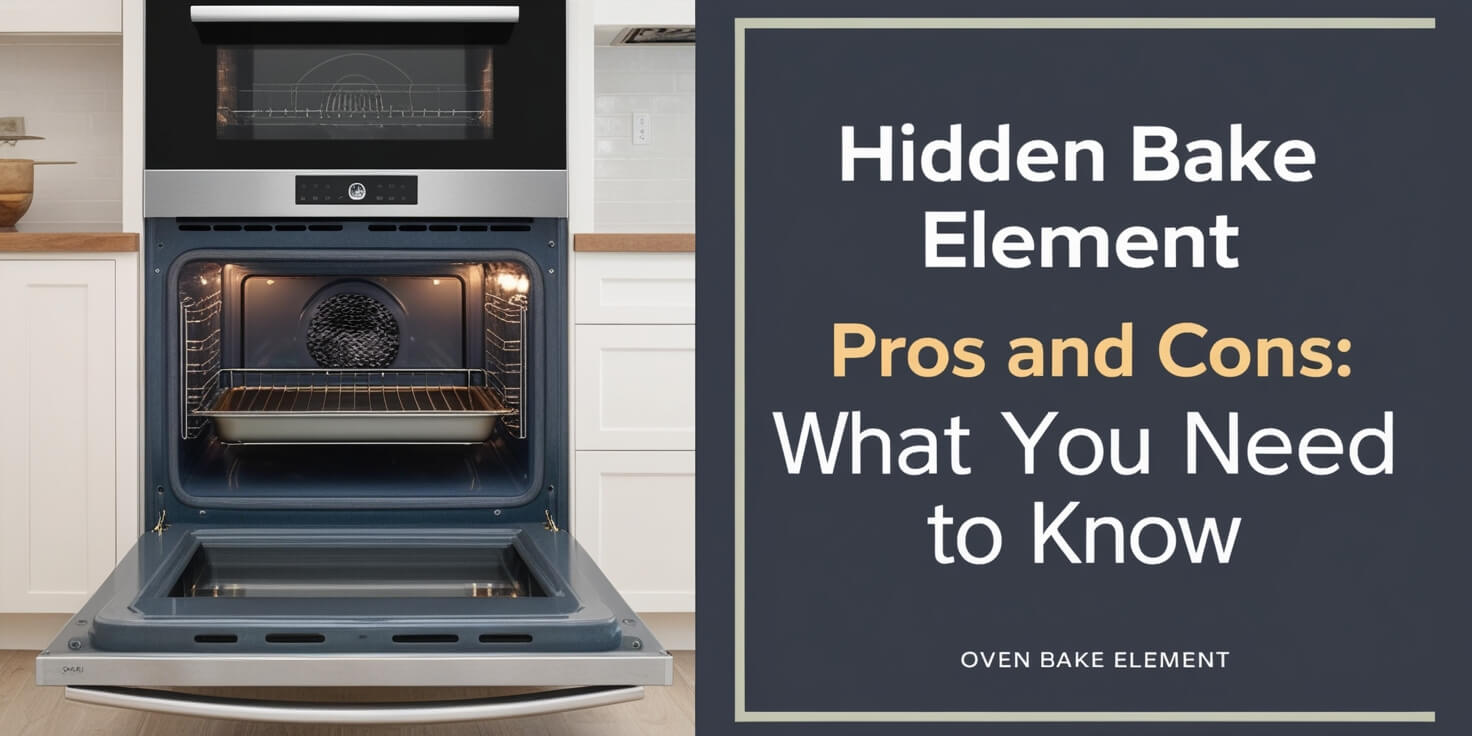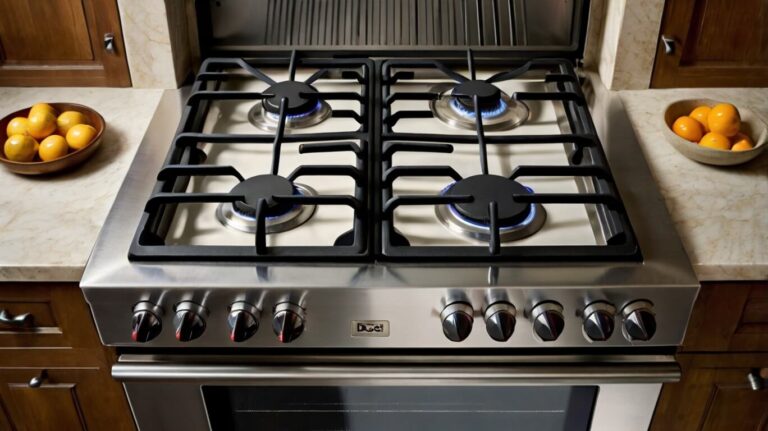
Hidden bake elements offer easier cleaning and a sleek look, but may increase preheat times and affect baking performance. This guide explores the advantages and drawbacks of hidden bake elements in ovens, helping you decide if they’re right for your kitchen.
What is a Hidden Bake Element?
Hidden bake elements are heating coils located beneath the oven floor, rather than exposed on top of it. This design change has become increasingly popular in modern ovens.
Definition and Basic Concept
A hidden bake element is a heating component concealed under the oven’s bottom panel. Unlike traditional exposed elements, it’s not visible when you open the oven door.
How Hidden Bake Elements Differ from Exposed Elements
The main difference lies in placement. Exposed elements sit on the oven floor, while hidden elements are tucked away underneath. This change affects cleaning, heat distribution, and overall oven performance.
The Evolution of Oven Design
Oven design has come a long way, with hidden elements representing a significant shift in approach.
Traditional Exposed Elements
For decades, ovens featured visible heating coils on the bottom. These elements were easy to access but often collected spills and were tricky to clean around.
The Shift to Hidden Bake Elements
Around 25 years ago, manufacturers began introducing hidden elements. This change aimed to solve cleaning issues and give ovens a more streamlined look.
Current Trends in Oven Technology
Today, hidden elements are standard in many electric ovens. They’re often paired with convection fans and smart features for improved cooking performance.
Advantages of Hidden Bake Elements
Hidden elements bring several benefits to the table.
Easier Cleaning and Maintenance
With no exposed coils, the oven floor becomes a smooth, wipe-clean surface. This makes tackling spills and messes much simpler.
Improved Aesthetics and Modern Look
Hidden elements create a sleek, uncluttered oven interior. This modern look appeals to many homeowners and can enhance kitchen aesthetics.
Enhanced Safety Features
Concealed elements reduce the risk of accidental burns from touching hot coils. They also prevent spills from coming into direct contact with heating elements.
Better Heat Distribution
Some users report more even baking with hidden elements, as heat radiates more uniformly from the oven floor.
Disadvantages of Hidden Bake Elements
Despite their benefits, hidden elements also have some drawbacks.
Longer Preheat Times
The oven floor acts as a barrier, slowing heat transfer. This can increase preheat times by about 5-10 minutes compared to exposed elements.
Potential Impact on Baking Performance
Some bakers find that hidden elements affect the crispy bottom crust on items like pizzas or bread. The indirect heat may not provide the same intense bottom heat as exposed coils.
Increased Repair Complexity
When hidden elements fail, they’re harder to access and replace. This can lead to higher repair costs and longer downtime.
Higher Energy Consumption
Longer preheat times and the need to heat the oven floor can result in slightly higher energy use over time.
Impact on Cooking and Baking
Hidden elements can affect your cooking and baking in various ways.
Effects on Different Types of Dishes
Dishes that benefit from direct bottom heat, like pizzas, may need recipe adjustments. However, many users find that cakes and cookies bake more evenly with hidden elements.
Adjusting Recipes for Hidden Element Ovens
You might need to extend cooking times slightly or adjust rack positions to compensate for the different heat distribution.
Professional Chefs’ Opinions
Many professional chefs prefer exposed elements for their responsiveness and ability to create a crisp bottom crust. However, some appreciate the even heat of hidden elements for delicate baked goods.
Comparing Hidden Elements to Other Oven Types
Let’s see how hidden element ovens stack up against other options.
Gas vs. Electric with Hidden Elements
Gas ovens typically don’t have hidden elements, offering more direct heat. Electric ovens with hidden elements provide more even heating but may lack the instant response of gas.
Convection Ovens with Hidden Elements
Many modern ovens combine hidden elements with convection fans. This pairing can offset some of the drawbacks of hidden elements by improving heat circulation.
Induction Ranges and Hidden Elements
Induction cooktops are often paired with hidden element ovens in high-end ranges. This combination offers precise stovetop control with the benefits of hidden elements in the oven.
Maintenance and Longevity
Proper care can help your hidden element oven last longer.
Lifespan of Hidden Bake Elements
Hidden elements typically last between 5-10 years, similar to exposed elements. However, their lifespan can vary based on usage and maintenance.
Common Issues and Troubleshooting
Signs of a failing hidden element include uneven heating, longer preheat times, or the oven not reaching the set temperature. If you notice these issues, it’s time to call a repair service.
Cleaning Tips for Hidden Element Ovens
Wipe spills promptly to prevent baked-on messes. Avoid harsh scrubbers that could damage the oven floor. Many models offer a steam clean feature for easier maintenance.
Energy Efficiency Considerations
Hidden elements can affect your oven’s energy use.
Power Consumption Comparison
While hidden elements may use slightly more energy due to longer preheat times, the difference is often minimal in overall household energy use.
Environmental Impact
The small increase in energy use is offset by the longer lifespan of hidden elements, which means less frequent replacement and waste.
Energy-Saving Tips for Hidden Element Ovens
Use convection mode when possible, avoid frequent door opening, and consider skipping preheating for dishes that don’t require it to save energy.
Cost Analysis
Let’s break down the financial aspects of hidden element ovens.
Initial Purchase Price Differences
Ovens with hidden elements often cost slightly more than those with exposed elements. The price difference is usually $50-$100.
Long-term Operating Costs
The slightly higher energy use of hidden elements may increase operating costs, but the difference is typically small – often just a few dollars per year.
Repair and Replacement Expenses
When hidden elements need replacement, the repair cost can be higher due to increased labor. Budget for potential repair costs when choosing an oven.
Consumer Reviews and Experiences
Real-world feedback offers valuable insights into hidden element ovens.
What Users Love About Hidden Elements
Many users rave about the easy cleaning and sleek look. They also appreciate the even baking results for items like cookies and cakes.
Common Complaints and Concerns
Longer preheat times are a frequent complaint. Some users also miss the ability to use aluminum foil on the oven floor, which isn’t recommended with hidden elements.
Real-life Testimonials
“I love how easy it is to clean my hidden element oven. No more scrubbing around coils!” – Sarah, home baker
“The preheat time is a bit longer, but the even baking results are worth it.” – Mike, cooking enthusiast
Choosing the Right Oven for Your Needs
Consider these factors when deciding on a hidden element oven.
Factors to Consider When Buying
Think about your cooking style, cleaning preferences, and kitchen aesthetics. If you frequently bake pizzas or bread, an exposed element might be better.
Best Hidden Element Ovens in the Market
Popular models include the GE Profile series and KitchenAid convection ovens with hidden elements. Research current models and read reviews before buying.
Is a Hidden Element Oven Right for You?
If easy cleaning and a modern look are priorities, and you don’t mind slightly longer preheat times, a hidden element oven could be a great choice.
Future of Oven Technology
Oven design continues to evolve, with hidden elements playing a role.
Emerging Trends in Oven Design
Smart ovens with Wi-Fi connectivity and app control are becoming more common. Many of these incorporate hidden elements for a sleek look.
Potential Improvements to Hidden Elements
Future designs may focus on reducing preheat times and improving energy efficiency while maintaining the benefits of hidden elements.
What to Expect in Next-Generation Ovens
Look for ovens with adaptive cooking algorithms, improved insulation, and perhaps even combination heating methods that blend the best of hidden and exposed elements.
Conclusion: Weighing the Pros and Cons of Hidden Bake Elements
Hidden bake elements offer significant advantages in terms of cleaning ease and aesthetics. However, they come with trade-offs like longer preheat times and potential baking adjustments. By considering your cooking style, cleaning preferences, and kitchen design, you can decide if a hidden element oven is the right choice for your home. Remember, the best oven is one that fits your specific needs and helps you create delicious meals with ease.






